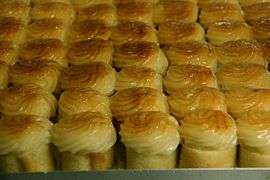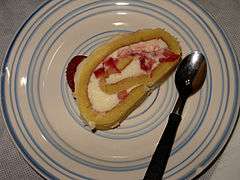Pionono
 | |
| Type | Pastry |
|---|---|
|
| |
Pionono is any of several varieties of pastry popular in Spain, South America, and the Philippines. It is named after Pope Pius IX's Italian name, "Pio Nono".[1]
Spain
Piononos are small pastries traditional in Santa Fe, a small town adjacent to the city of Granada, Spain. A pionono has two parts: a thin layer of pastry rolled into a cylinder, fermented with different kinds of syrup which give the pionono a sweet and pleasant texture, crowned with toasted cream. It is typically eaten in one or two bites.
South America and Cuba
In various South American countries such as Argentina, Uruguay, Venezuela, Colombia, Peru and Cuba, piononos are prepared using a dough made of flour, eggs, and sugar, which is baked in a thin sheet then rolled around a filling of dulce de leche sometimes with walnuts, or fruits like strawberries with chantilly cream, or in the case of savoury piononos with York ham, cheese, tomato and mayonnaise, or a savory salad, such as ham salad with asparagus and lettuce, chicken salad or even tuna. In Cuba and in several other countries it is also called "Brazo de Gitano" or "Brazo Gitano".
Puerto Rico
In Puerto Rico, Piononos are prepared using yellow, or sweet plantain as the "bread" around a savory filling. It is usually stuffed with a meat filling called Picadillo or seafood with cheese, the whole sandwich is dipped in a batter made from flour and eggs then deep-fried.
Philippines
In the Philippines, the pionono, or pianono, is similar to a jelly roll. It consists of a layer of pastry made from eggs, sugar, and sifted flour baked in a sheet. Once cooled, jelly or other types of filling is spread over the pastry. It is then rolled from one end to the other. The filling may be sweet or savory.
Gallery
 Piononos from Santa Fe, Spain
Piononos from Santa Fe, Spain- Homemade Argentine piononos
- Sliced Argentine pionono
 Sweet Argentine piononos
Sweet Argentine piononos Sliced sweet Argentine pionono
Sliced sweet Argentine pionono Sweet Argentine piononos with dulce de leche
Sweet Argentine piononos with dulce de leche
See also
References
- ↑ Fenix, Mickey (28 August 2014). "‘Bibingka,’ ‘monay,’ ‘escandaloza’ and other curious names of Philippine baked goodies". Inquirer.net. Retrieved 4 December 2014.